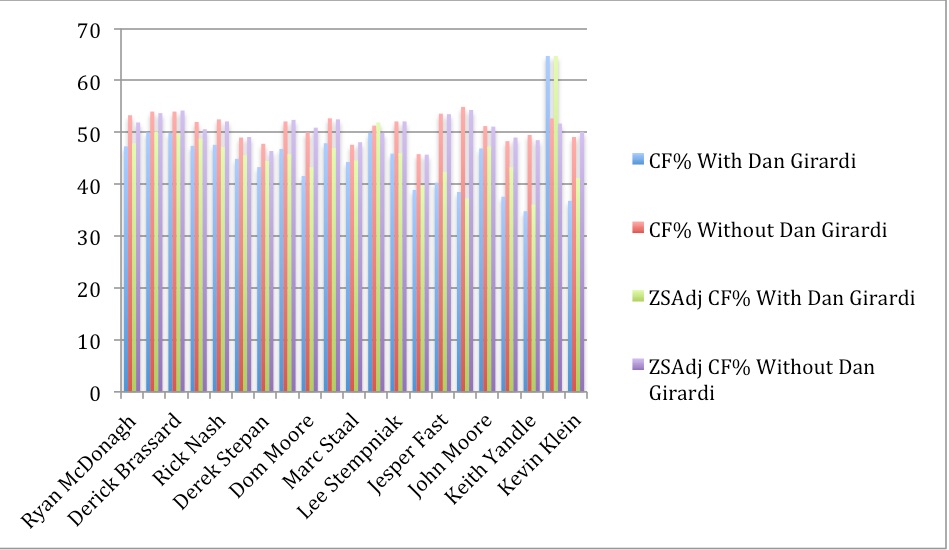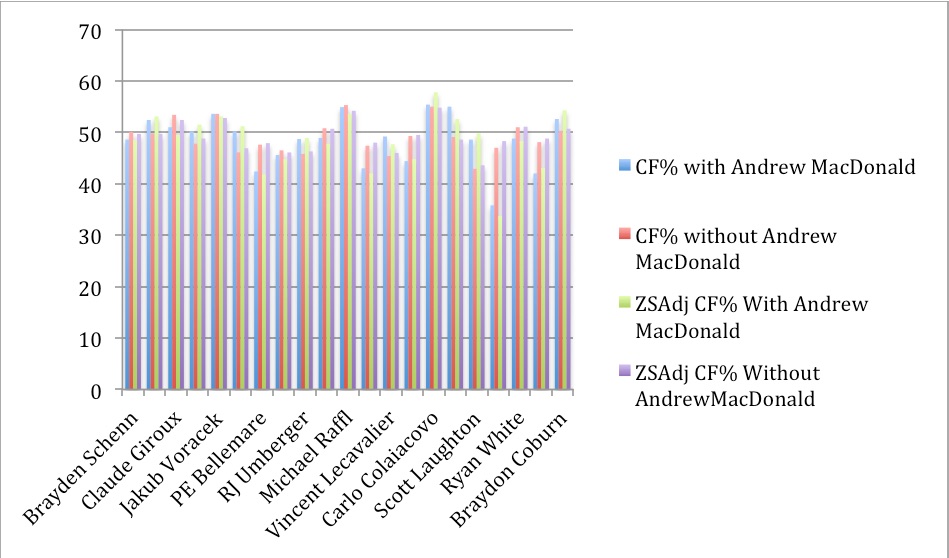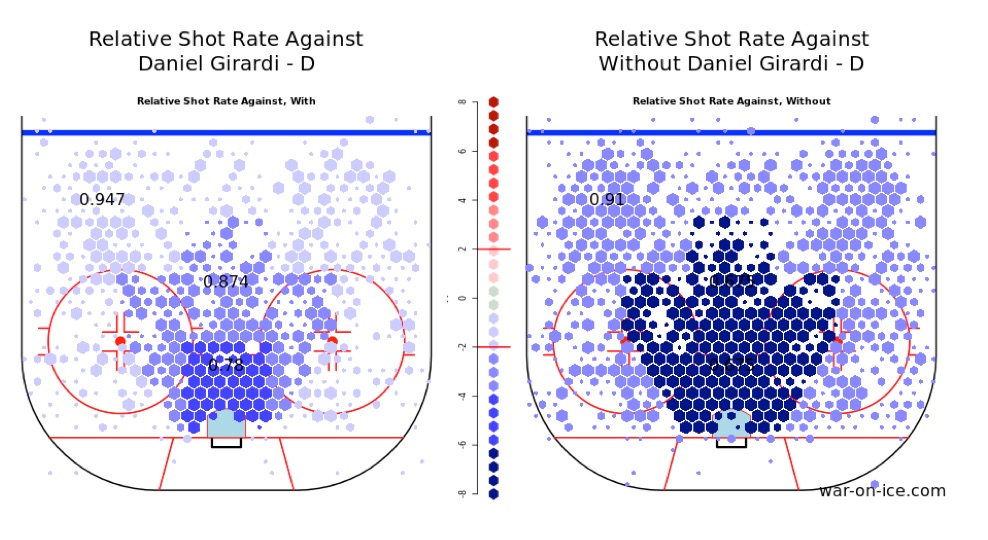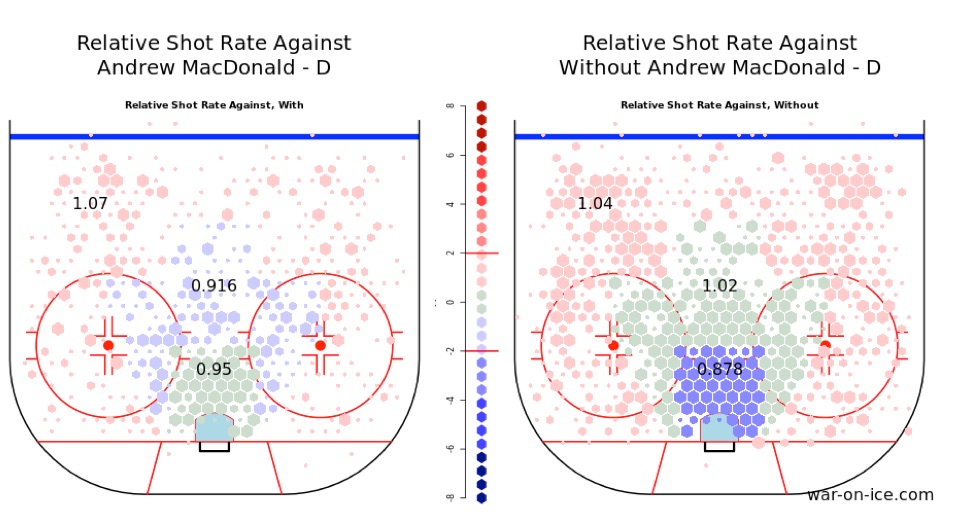This is a guest post received from Pat Keogh, who reached out to me yesterday with this idea. It was something I touched on via Twitter, and Patrick does a great job summing it up. Be sure to follow him on Twitter here.
The Philadelphia Flyers placed defenseman Andrew MacDonald on waivers this week, sparking some discussion on Twitter due to the size of his contract and his reputation as a reliable, shot blocking, “stay at home” defenseman. Rangers fans in particular may have found amusement in a close rival making this kind of roster move, but also perhaps frustration, given the similarities between Andrew MacDonald and Rangers stalwart Dan Girardi. At the same time as Girardi detractors can seem overly critical, apologists for the defenseman often ephemeral qualities such as “grit” or “heart”. A closer look at the stats helps clarify the comparison, which may bear more similarities than some Rangers fans would like.
Below are graphs of Girardi and MacDonald’s respective WOWY (With Or Without You) CF% numbers, including CF% as well as zone start adjusted CF%. While many of MacDonald’s teammates demonstrate a larger share of the shot attempts taken on ice without MacDonald, the same could be said for a greater proportion of Girardi’s teammates. Here we see the comparison is actually less flattering for Dan Girardi than for Andrew MacDonald.
First up is Girardi. The below chart shows that, generally speaking, his teammates drive possession better when he is off the ice. The numbers are adjusted for zone starts as well (ZSAdj).
And now MacDonald. The numbers are eerily similar, minus the spike for Keith Yandle.
The two players’ hextally charts, which show average shot locations allowed while the player is on the ice, provide some defense for fans of Dan Girardi, but place both defensemen in fairly damning light. Although the relative shot rates from various locations are farther from the league average for Dan Girardi than they are for Andrew MacDonald, the numbers are more favorable for the players’ respective teams with them off the ice than on.
First is Girardi, where we see the Rangers do a better job keeping shots to the outside (the darker blue on the right) when he is off the ice. The Rangers don’t do a poor job with him on the ice (the left chart is still dark blue), but they are better with him off the ice.
Next is MacDonald, who is pretty terrible at limiting quality shot attempts. That’s a lot of red.
The two players’ HERO graphs demonstrate a slight edge for Girardi over MacDonald in terms of offensive production, but demonstrate a sizeable disparity between their respective Corsi production and ice time.
First is Girardi, where we see Girardi getting top pairing minutes, but bottom pairing production. When it comes to pushing possession and limiting the opposition’s shot attempts, he’s worse than bottom pairing.
Now MacDonald, who also gets top pairing minutes, but those are some ugly, ugly numbers.
In Girardi’s defense, he does play longer per game on average, about a minute longer per game. In 82 games last regular season he had 3 goals and 13 assists (at even strength) to MacDonald’s 1 goal and 5 assists in 58 games. He also typically plays against opponents’ top competition alongside his defensive partner, Ryan McDonagh.
Overall, although his numbers are better in some aspects than MacDonald’s, Dan Girardi is a frighteningly close comparison to a player that recently hit waivers. While his hextally isn’t as bad as MacDonald’s, it’s still pretty damning that the shot rates are closer to the league average with him on the ice than off. The fact that the vast majority of his teammates display a higher percentage of shot attempts without him on the ice, something that can’t quite be said for Andrew MacDonald, is similarly discouraging.
Although some Rangers fans might laugh at the Flyers placing Andrew MacDonald on waivers, the similarities between him and Dan Girardi, both in terms of statistics, as well as the kind of game they play and the size of their contracts are no laughing matter. The case of Andrew MacDonald and the similarities to Dan Girardi’s situation might mean it’s time to reconsider the praise and price that defensive, shot blocking, “stay at home” defensemen receive.
Share:
More About:Defense







